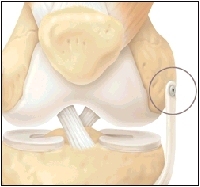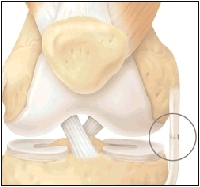Treating Medial Collateral Ligament (MCL) Problems
Pre-Op Checklist
-
Stop taking aspirin and other medications as advised by your doctor 7 days before surgery.
-
Arrange to get crutches to use during recovery.
-
Don't eat or drink 10 hours before surgery.
-
Arrange for someone to drive you home after surgery.
There are two options for treating an MCL injury: nonsurgical and surgical. Nonsurgical treatment is used more often. With either option, rehabilitation will be part of your treatment.
Nonsurgical Treatment
This treatment starts with rest, icing, and elevation. This relieves pain and swelling. In the next stage, you begin exercises designed to increase your knee's range of motion, strength, and flexibility. Using crutches or a brace rests your joint, helping it to heal.

Your doctor may secure the ligament to the bone with screws.

Your doctor may stitch or staple your ligament together.
Surgery
Surgery is seldom used to repair an MCL injury. But sometimes it is advised, especially if another part of your knee is damaged. Open surgery is used to screw, staple, or stitch the MCL back into place. Depending on their location, other knee injuries may be repaired using arthroscopy. With arthroscopy, a tiny camera lets your doctor see inside the joint. Tools inserted through small incisions are used to repair the joint.
After Surgery
Right after surgery, you'll spend a few hours in a recovery unit. Your knee will be bandaged and your leg elevated. Your knee will also be iced and put in a brace to keep it from bending. Depending on the procedure, your physical therapy may begin shortly after surgery. This may include light exercises.






